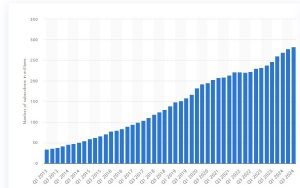Table of Contents
- Introduction
- Overview of the streaming industry
- Recent trends in India and Global
- Research objectives
- Company Profiles
- Netflix
- Amazon Prime Video
- Disney+ Hotstar
- Industry Analysis
- Key characteristics of the streaming industry
- Strengths, Weaknesses, Opportunities, and Threats for the Industry
- SWOT, PESTEL & Porter’s Five Forces Analysis
- Strengths, Weaknesses, Opportunities, and Threats for each company
- PESTEL Analysis
- Porter’s Five Forces Analysis
- Competitive Analysis
- Content strategy
- Pricing strategy
- Distribution strategy
- Challenges and Opportunities
- Content acquisition and production
- Subscriber acquisition and retention
- Technological innovation
- Global expansion
- Conclusion
- Summary of key findings
- Future implications for the streaming industry
- Potential research questions/Scope for Further Research
- References**
- Appendices** (optional, for additional data or supporting information)
Case Study: The Streaming Wars – Netflix, Amazon Prime, and Disney+ Hotstar
Table of Contents
- Introduction
- Overview of the streaming industry
The streaming industry is a rapidly growing sector that has revolutionized how people consume entertainment content.[1] With the rise of high-speed internet and affordable devices, streaming platforms have gained immense popularity, offering a vast library of movies, TV shows, documentaries, and original content.[2] Key players in the streaming wars include Netflix, Amazon Prime Video, and Disney+ Hotstar, each vying for a larger share of the market by producing exclusive content, offering diverse genres, and expanding their global reach. The competition among these giants is driving innovation and shaping the future of entertainment consumption.
- Recent trends in India and Global
Recent trends in the OTT industry include a shift towards regional language content in India, with platforms like Disney+ Hotstar and Amazon Prime Video investing heavily in regional productions. Globally, there’s a growing focus on original content, with streaming giants like Netflix and Amazon Prime producing high-quality shows and movies. Additionally, the rise of ad-supported tiers and bundling services with telecom providers are shaping the industry. The future of OTT lies in personalized recommendations, immersive viewing experiences, and innovative business models to cater to diverse audience preferences.
- Research objectives
- Market Analysis: To analyze the current state of the global and Indian streaming market, including market size, growth rate, and key trends.
- Competitive Landscape: To evaluate the competitive landscape of major streaming platforms, focusing on Netflix, Amazon Prime Video, and Disney+ Hotstar, including their strategies, strengths, weaknesses, opportunities, and threats (SWOT).
- Consumer Behavior: To understand the preferences, viewing habits, and satisfaction levels of streaming subscribers, including factors influencing their choices and loyalty.
- Content Strategy: To examine the content strategies of leading platforms, including original content production, licensing, and distribution models.
- Technological Advancements: To assess the impact of emerging technologies like AI, VR, and AR on the streaming industry, and potential future trends.
- Business Model Innovation: To explore innovative business models, pricing strategies, and monetization techniques employed by streaming platforms.
- Regulatory Environment: To analyze the regulatory landscape and its impact on the streaming industry, including content regulations, taxation, and data privacy.
- Company Profiles
- Netflix
Netflix, a global streaming giant, revolutionized the entertainment industry by offering a vast library of movies and TV shows on-demand. Founded in 1997, it initially started as a DVD-by-mail service but transitioned to streaming in 2007. Known for its original content, Netflix produces critically acclaimed series like “Stranger Things,” “Squid Game,” and films like “Roma” and “The Power of the Dog.” With a massive subscriber base worldwide, Netflix continues to innovate and expand its offerings, shaping the future of entertainment consumption.
- Amazon Prime Video
Amazon Prime Video, a subsidiary of Amazon, is a popular streaming service offering a vast library of movies, TV shows, and original content. Launched in 2006, it initially started as a video-on-demand service but has since evolved into a major player in the streaming industry. Prime Video offers exclusive series like “The Marvelous Mrs. Maisel” and “The Boys,” as well as popular movies and licensed content. It’s part of the Amazon Prime membership, providing additional benefits like free shipping and music streaming.
- Disney+ Hotstar
Disney+ Hotstar is a popular streaming platform in India, offering a vast library of movies, TV shows, and live sports. It’s a joint venture between The Walt Disney Company and Star India. The platform offers a diverse range of content, including Hollywood blockbusters, Disney classics, popular Indian TV shows, and live cricket matches. It has gained significant popularity due to its extensive content library, user-friendly interface, and affordable subscription plans.
- Industry Analysis
- Key characteristics of the streaming industry
The streaming industry is characterized by:
- High Competition: Intense rivalry among major players like Netflix, Amazon Prime Video, and Disney+ Hotstar.[3]
- Content is King: Original content production, licensing, and distribution are crucial for attracting and retaining subscribers.[4]
- Technology-Driven: Reliance on advanced technologies for content delivery, personalization, and user experience.[5]
- Global Reach: Expanding operations to international markets and catering to diverse cultural preferences.[6]
- Subscription-Based Model: Primarily driven by subscription fees, with some platforms offering ad-supported tiers.[7]
- Evolving Business Models: Continuous innovation to adapt to changing consumer behavior and technological advancements.[8]
- Regulatory Challenges: Navigating complex regulatory landscapes and content restrictions across different regions.[9]
- Strengths, Weaknesses, Opportunities, and Threats for the Industry
SWOT Analysis of the Streaming Industry
Strengths
- Global Reach: The ability to reach a global audience, transcending geographical boundaries.
- Diverse Content Library: A vast array of content, catering to diverse tastes and preferences.
- Technological Advancements: Leveraging technology for personalized recommendations, immersive viewing experiences, and efficient content delivery.
- Strong Brand Equity: Established brands with loyal customer bases.
Weaknesses
- High Content Costs: Significant investments in original content production.
- Intense Competition: Fierce competition among major players.
- Piracy and Content Theft: Challenges in protecting intellectual property rights.
- Subscription Fatigue: Potential for subscriber churn as consumers face multiple subscription costs.
Opportunities
- Emerging Markets: Expanding into new markets with growing internet penetration.
- Technological Innovations: Exploring emerging technologies like VR, AR, and AI for enhanced user experiences.
- Mobile-First Strategy: Capitalizing on mobile devices for content consumption.
- Strategic Partnerships: Collaborating with telecom providers, device manufacturers, and content creators to expand reach and offerings.
Threats
- Economic Downturns: Economic downturns can impact consumer spending and subscription rates.
- Regulatory Challenges: Changes in regulations can impact content licensing, taxation, and data privacy.
- Technological Disruptions: Rapid technological advancements can disrupt the industry.
- Shifting Consumer Preferences: Changes in consumer preferences can impact content consumption habits.
- SWOT, PESTEL & Porter’s Five Forces Analysis
- Strengths, Weaknesses, Opportunities, and Threats for each company
SWOT Analysis of Netflix
- Strengths : Strong brand, global reach, data-driven approach, original content
- Weaknesses : High content costs, dependence on subscriptions
- Opportunities : Expansion into gaming, interactive content
- Threats : Increased competition, changing consumer preferences
SWOT Analysis of Amazon Prime Video
- Strengths : Strong brand, large customer base, bundled services, diverse content
- Weaknesses : Lower brand recognition for video content, reliance on Amazon’s core business
- Opportunities : Focus on original content, geographic expansion
- Threats : Intense competition, economic downturns
SWOT Analysis of Disney+ Hotstar
- Strengths : Strong brand, diverse content library, large subscriber base in India, live sports
- Weaknesses : Reliance on Disney content, geographic limitations
- Opportunities : Global expansion, original content creation
- Threats : Competition from other streaming platforms, piracy
- PESTEL Analysis
Political Factors
- Government regulations: Content censorship, data privacy laws, net neutrality, taxation policies on streaming services, and copyright regulations.
- Geopolitical factors: International trade agreements, political scenario in key markets, and government subsidies for local content production.
- Media ownership laws: Restrictions on foreign ownership of media companies and content distribution.
Economic Factors
- Economic growth: Consumer spending power, Purchase power parity, disposable income levels, and economic cycles, Inflation
- Currency exchange rates: Impact on content acquisition costs and pricing strategies.
- Inflation: Affects production costs, subscription fees, and consumer spending.
- Competition intensity: Level of competition from other streaming platforms and traditional media.
Social Factors
- Demographic changes: Age distribution, gender, urbanization, and changing consumer preferences.
- Cultural trends: Shifts in entertainment consumption habits, social media influence, and content preferences.
- Lifestyle changes: Increasing reliance on digital media, cord-cutting, and time spent on streaming platforms.
Technological Factors
- Technological advancements: Video compression, streaming quality, artificial intelligence, virtual reality, and augmented reality.
- Digital infrastructure: Broadband penetration, internet speeds, and mobile technology.
- Cybersecurity: Protecting user data and preventing content piracy.
Environmental Factors
- Sustainability: Environmental impact of data centers, energy consumption, and waste management.
- Climate change: Potential disruptions to production and distribution.
Legal Factors
- Copyright laws: Protecting intellectual property and preventing content piracy.
- Consumer protection laws: Fair competition, data privacy, and consumer rights.
- Tax regulations: Corporate taxes, sales taxes, and international tax treaties.
- Porter’s Five Forces Analysis
Porter’s Five Forces Model is a strategic tool used to analyze the competitive intensity and attractiveness of an industry. It considers five key factors:
- Threat of new entrants:
- High barriers to entry: Significant capital investment (content licensing, original production), high brand recognition, and technological expertise.
- Low threat of new entrants: The streaming industry is highly competitive, and new entrants face significant challenges in gaining market share.
- Bargaining power of buyers:
- High bargaining power: Consumers have a wide range of choices and can easily switch between platforms.
- Low bargaining power: While consumers have some bargaining power, the industry is dominated by a few major players.
- Bargaining power of suppliers:
- High bargaining power: Content creators (studios, production houses) have significant bargaining power due to the demand for exclusive content.
- Low bargaining power: While content creators have bargaining power, streaming platforms can negotiate terms based on their market position and scale.
- Threat of substitute products:
- High threat of substitutes: Cable TV, satellite TV, and free-to-air television are potential substitutes, but the trend towards cord-cutting favors streaming platforms.
- Low threat of substitutes: Streaming platforms offer convenience, on-demand access, and a wider range of content compared to traditional television.
- Intensity of rivalry among existing competitors:
- High intensity of rivalry: The streaming industry is highly competitive, with established players like Netflix, Amazon Prime, and Disney+ Hotstar, as well as emerging competitors.
- Low intensity of rivalry: While competition is intense, players may collaborate on certain aspects, such as technology standards or content distribution.
Overall, the streaming industry is characterized by:
- High barriers to entry: Significant capital investment and technological expertise are required.
- Moderate bargaining power of buyers: Consumers have choices but are not easily swayed.
- High bargaining power of suppliers: Content creators hold significant power.
- Moderate threat of substitute products: Traditional television is a potential substitute, but the trend towards cord-cutting favors streaming.
- High intensity of rivalry: The industry is highly competitive, with established players and emerging competitors.
- Competitive Analysis
- Content strategy
Netflix excels in original content with a global appeal, while Amazon Prime Video focuses on a diverse library including original series, licensed content, and regional language shows. Disney+ Hotstar leverages its vast library of Disney content, popular Indian TV shows, and live sports to attract a broad audience. Each platform differentiates itself through unique content strategies, catering to specific audience segments and leveraging their strengths to compete in the crowded streaming market.
- Pricing strategy
Netflix primarily relies on a subscription-based model with various pricing tiers offering different features like HD and 4K streaming, and multiple simultaneous streams. Amazon Prime Video is bundled with Amazon Prime membership, offering additional benefits beyond streaming. Disney+ Hotstar offers multiple subscription plans, including mobile-only, standard, and premium tiers, catering to diverse consumer needs. Each platform employs strategic pricing strategies to balance affordability, revenue generation, and value proposition.
- Distribution strategy
Netflix focuses on direct-to-consumer distribution through its app and website, ensuring a seamless user experience. Amazon Prime Video leverages Amazon’s extensive distribution channels, including Fire TV devices and integration with Alexa. Disney+ Hotstar utilizes a multi-platform approach, distributing content through its app, website, and partnerships with cable and satellite TV providers. Each platform optimizes its distribution strategy to reach a wide audience and maximize engagement.
- Challenges and Opportunities
- Content acquisition and production
OTT platforms face challenges like high content acquisition costs, piracy, and competition for exclusive content. However, they also have opportunities to leverage emerging technologies like AI and machine learning for content personalization and recommendation. Additionally, strategic partnerships with content creators and producers can help secure exclusive content and reduce costs.
- Subscriber acquisition and retention
OTT platforms face challenges like subscriber fatigue, price sensitivity, and competition for user attention. However, they have opportunities to leverage personalized recommendations, exclusive content, and innovative marketing strategies to acquire and retain subscribers. Offering bundled services, free trials, and loyalty programs can also help attract and retain customers.
- Technological innovation
OTT platforms face challenges like the rapid pace of technological advancements, cybersecurity threats, and the need for constant infrastructure upgrades. However, they have opportunities to leverage emerging technologies like AI, VR, and AR to enhance the user experience, personalize content, and create immersive viewing experiences. Additionally, investing in robust cybersecurity measures can protect user data and build trust.
- Global expansion
OTT platforms face challenges like cultural differences, language barriers, and regulatory hurdles when expanding globally. However, they have opportunities to tap into large, untapped markets with growing internet penetration. By localizing content, partnering with local distributors, and adapting to regional preferences, OTT platforms can successfully expand their global footprint.
- Conclusion
- Summary of key findings
The streaming industry is highly competitive, with key players like Netflix, Amazon Prime Video, and Disney+ Hotstar vying for market share. While original content, technology, and global expansion are crucial, challenges like piracy, content costs, and subscriber retention persist. Successful platforms will need to balance these factors, innovate continuously, and adapt to evolving consumer preferences to thrive in the dynamic streaming landscape.
- Future implications for the streaming industry
The future of the streaming industry is promising, with advancements in technology, AI, and VR offering new opportunities for personalized experiences and immersive content. The industry will continue to evolve, driven by factors like 5G, cloud computing, and the Internet of Things. However, challenges like piracy, content costs, and competition will remain. Successful platforms will need to adapt to these changes, prioritize user experience, and invest in innovative technologies to stay ahead in the ever-evolving streaming landscape.
- Potential research questions/Scope for Further Research
Further research could explore the impact of emerging technologies like AI and VR on the streaming industry. The effectiveness of personalized recommendations, the role of social media in driving viewership, and the impact of economic factors on subscription behavior can also be investigated. Additionally, a deeper analysis of the regulatory landscape and its implications for the industry could provide valuable insights.
- References
- Video Streaming Market Size, Share & Industry Analysis, By Component (Software and Content Delivery Services), By Channel (Satellite TV, Cable TV, Internet Protocol Television (IPTV), and OTT Streaming), By Revenue Model (Subscription-based, Transactional-based, and Advertising-based), By Vertical (Education/E-learning, Healthcare, Government, Sports/eSports, Gaming, Enterprise and Corporate, Auction and Bidding, Fitness & Lifestyle, Music & Entertainment, and Others), and Regional Forecast, 2024-2032 : Published On : November 11 2024 : Retrieved on November 29 2024
- How do streaming services work and, most importantly, make money? : Retrieved on November 29 2024
- An Investigation on the Streaming Industry: With the Case of Netflix : Published In Year 2023 : Retrieved on November 29 2024
- Platforms: Key Trends and Outlook : Published On July 25, 2024 : Retrieved on November 29 2024
- The Road to Personalization in the Streaming Space : Published On February 7 2020 : Retrieved on November 29 2024
- Explore the story of how Netflix became a global streaming powerhouse : Published On April 4 2024 : Retrieved on November 29 2024
- Free Ad-Supported Streaming TV: What Marketers Need to Know : Published On October 18 2024 : Retrieved on November 29 2024
- 4 OTT Business Models to Drive Revenue from Video Distribution : Published On April 26 2024 : Retrieved on November 29 2024
- What are the regulatory challenges and considerations related to the changing landscape of the entertainment industry? : Retrieved on November 29 2024
- Appendices
Number of Netflix paid subscribers worldwide from 1st quarter 2013 to 3rd quarter 2024 (in millions)

Top Video Streaming Statistics Of 2024
- Streaming services account for 40.3% of total television usage.
- In 2024, the video streaming market worldwide is estimated to reach $108.50 billion.
- 99% of American households have subscribed to at least one streaming service.
- YouTube captures 9.9% of video streaming time, making it the most favored video streaming platform worldwide.
- With 277.65 million subscribers, Netflix is the most subscribed SVOD platform worldwide.
- The livestream video gaming market is anticipated to have 1.3 billion users by the end of 2024.
- 5% of the internet users watched live streaming in Q4 2023.
Amazon Prime Statistics: Top Picks (2024)
Dive into the world of Amazon Prime with insightful statistics, revealing its impact, growth, and significance in the e-commerce landscape.
- 220 million people are subscribed to Amazon Prime.
- Amazon Prime generated over $40.2 billion in revenue in 2023
- Amazon has a 21% share of video streaming platforms in the United States as of 2023.
- Amazon Prime Video is projected to have 250 million subscribers by 2027.
- The United States will have 180 million Amazon Prime members in 2024.
- Over 82.20 million people use Amazon Prime Music globally.
- More than 375 million items were sold on the Amazon Prime Day Sale in 2023.
Disney+ Hotstar Editor’s Choice
- Disney+ Hotstar Statistics show that in the third quarter of 2024, Disney Plus generated revenue of USD 2,674 million.
- At the same time, a further decrease was observed, with Disney+ Hotstar app downloads hitting about 79 million.
- Disney+ Hotstar is expected to make about USD 1.5 billionin 2024, mainly because of the huge popularity of the IPL (Indian Premier League) and its exclusive Disney shows and movies.
- Moreover, this is the top OTT platform in India, with more than100 million active subscribers, 10% more than last year.
- Moreover, in the second quarter of 2024, the total number of subscribers resulted in 8 million.
- In the United States of America, Disney Plus is one of the most preferred SVOD platforms, with an 11%market share.
- Disney Hotstar’s monthly subscription rate is USD 4.99, and the yearly subscription rate is around USD 19.99.
- Disney Hotstar Statistics in 2024, the application’s ad revenue is estimated to be USD 750 million, and the average ad cost per thousand impressions is USD 2.5 million.
- Meanwhile, the average daily viewing time per user of Disney Hotstar is around 2.8 hours.
- Other content breakdowns are followed by Sports (40%), TV Shows (30%), Movies (20%), and Originals (10%).
For more detailed insights, strategic recommendations, or to conduct a similar in-depth market study, please contact info@maction.com. With expertise in tailored research solutions, Maction Consulting provides the insights needed to make data-driven decisions that elevate brand performance in the marketplace.





